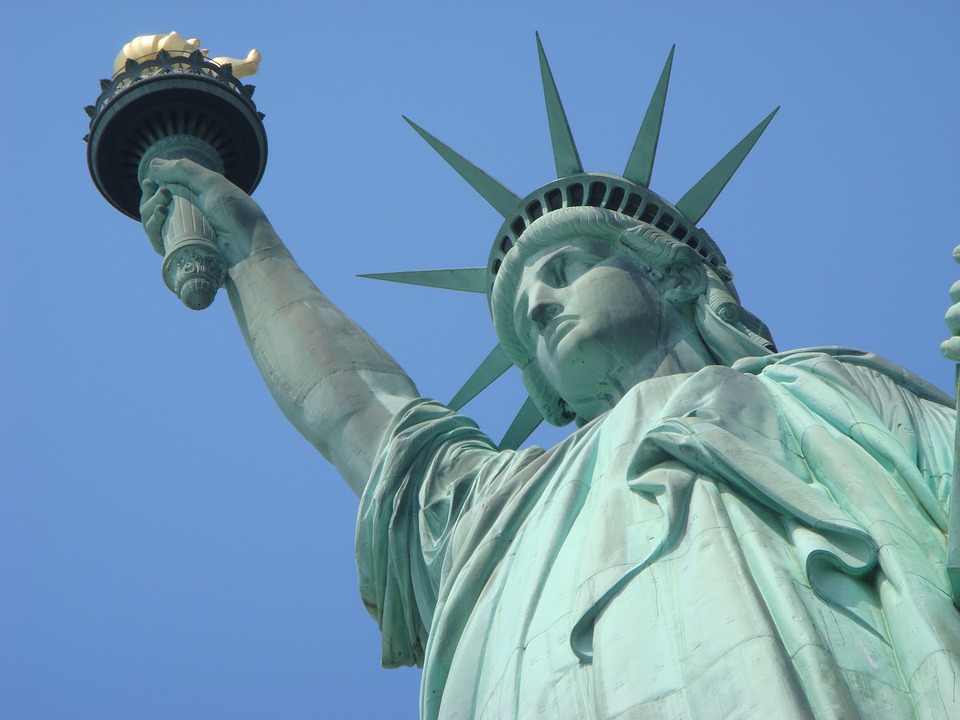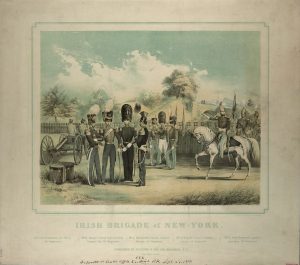On October 28, 1886, a 240-foot tall structure originally named “Liberty Enlightening the World” was revealed to an audience on Ellis Island in New York. This was the tallest structure in New York City, and it is still a great symbol in America today.1 Who would have known that a French sculptor and a French scholar would want to commemorate America for being a free nation for 100 years. These two individuals go by the names Frederic Auguste Bartholdi and Edouard-Rene Laboulaye.2 These two men met and created a sketch for the statue and wanted it to be a symbol of a “freedom-loving republic, a government in which power lay in the hands of the people, instead of a king.”3 The statue would also symbolize the alliance between France and America that began during the American War of Independence against Britain. There is a misconception that the statue was built to represent a welcoming icon for immigrants; however, this was not the initial purpose of the statue.4 France built the Statue of Liberty beginning in 1875. It was made out of 450,000 pounds of copper and steel. It was agreed by both nations that America was to be in charge of the pedestal, which weighed 27,000 tons, for the statue to rest on.5
In the construction of the statue, Bartholdi had used three hundred copper sheets to cover the entire statue. The reason why the statue appears to be green is due to its long exposure to the atmosphere over time. Something interesting is that the features of the statue’s face resemble those of Bartholdi’s mother and the arms resemble those of his wife. The Statue of Liberty is also presented wearing a long robe, which was influenced by ancient Greek and Rome attire. The purpose of this was to serve as a reminder of the ideals of that ancient era.6

The statue is carrying a tablet in her left hand with the year “1776” written on it, which is the year that Congress signed the Declaration of Independence. The significance behind this is to serve as a reminder that “all men are created equal.” It also reinforces the idea that if the government fails to abide by the natural rights of “life, liberty, and the pursuit of happiness,” then the citizens have the right to establish a new government by overthrowing the current one. This tablet also serves as a religious reminder of the Ten Commandments that Moses received when God revealed himself to him on Mount Sinai. The torch that is held in Liberty’s right hand symbolizes the light that the United States carries for the entire world. This suggests that nations should follow America’s political system, according to the French architects. She is also wearing a crown with sun rays beaming from it called a “diadem.” This refers to the ancient sun god, Helios.7
In 1884, the entire statue was done being constructed in France; however, due to its large size, it was packed into two hundred cases to be transported to New York.8 The place where the statue was assembled was Ellis Island. The statue is known as the “centerpiece of a magical American place,” since her popularity will grow through being imaged in magazines, newspapers, postcards, among other things.9 One issue with building the statue was the funding for the statue’s pedestal, since the U.S. government was not willing to pay for the construction of it. One way this was done was by fundraising and donations from various contributors, such as Joseph Pulitzer and Emma Lazarus. Pulitzer published in the New York World newspaper asking for donations for this statue. Lazarus wrote a poem at a fund-raising auction to help the funding of the statue’s pedestal.10
The unveiling of the statue was on a foggy, raining day on October 28, 1886. Millions of people witnessed this revelation and took part in a parade held in Manhattan. The President at the time was Grover Cleveland. He gave a speech at the ceremony about freedom and America’s democracy. However, immigration was not mentioned in this speech. The Statue of Liberty was the first major icon that immigrants would see as they came to America. The Statue of Liberty is an important icon in American history and is still a valued symbol today. The story behind its development and upbringing involved the interaction between France and the U.S. The purpose of the construction of this statue is to recognize America’s political system, its dependence on the ideals of freedom, and how America serves as a symbol of hope and a new start for immigrants.11
- Dictionary of American History, 2003, s.v. “Statue of Liberty,” by John Higham. ↵
- UXL Encyclopedia of U.S. History, 2009, s.v. “Statue of Liberty,” by Sonia Benson, Daniel E. Brannen, Jr., and Rebecca Valentine. ↵
- James L. Outman, Statue of Liberty In U.S. Immigration and Migration Reference Library (Detroit: UXL, 2004), 364. ↵
- James L. Outman, Statue of Liberty In U.S. Immigration and Migration Reference Library (Detroit: UXL, 2004), 364-365. ↵
- Dictionary of American History, 2003, s.v. “Statue of Liberty,” by John Higham. ↵
- James L. Outman, Statue of Liberty In U.S. Immigration and Migration Reference Library (Detroit: UXL, 2004), 366-367. ↵
- James L. Outman, Statue of Liberty In U.S. Immigration and Migration Reference Library (Detroit: UXL, 2004), 368-369. ↵
- James L. Outman, Statue of Liberty In U.S. Immigration and Migration Reference Library (Detroit: UXL, 2004), 369. ↵
- Dictionary of American History, 2003, s.v. “Statue of Liberty,” by John Higham. ↵
- James L. Outman, Statue of Liberty In U.S. Immigration and Migration Reference Library (Detroit: UXL, 2004), 365-370. ↵
- James L. Outman, Statue of Liberty In U.S. Immigration and Migration Reference Library (Detroit: UXL, 2004), 370-374. ↵



93 comments
Edith De Loera
Upon reading this article, I found that every single detail in the monument has a significance. The Statue of Liberty presents many themes and shows the great alliance we had with France. I have visited New York on various occasions and make sure to always make it a point to pay a visit to Lady Liberty! Its beauty is truly mesmerizing, and the history behind it is even better.
Carlos Aparicio
The Statue of Liberty is one of my favorite American Monuments and I found out a lot of information about it in this article. This article gave me so much information on regarding its physical attributes. I had no idea that it was a gift from France for Americas’s 100 years of Freedom. One thing that amazed me by this story was that is was transported from France to the United States of America! This article is very informative in which I admire for all the research gone into this.
Samuel Stallcup
Although I have never seen the Statue of Liberty in person, I would love see its gigantic mass for, like you said in the article, has always been an iconic symbol in American history and culture. I never knew that it required 200 cases to be transported, and I was disappointed to read that the U.S. government was unwilling to pay for its construction. Thank you, Frenchmen.
Troy Leonard
I have to say you did a great job on giving us a lot of background and history about the statue of liberty. I didn’t really know a lot about it other then that it was in new York and it symbolized that this was the land of the free. I also didn’t know that is was only green because of wreathing and nature so it would be cool to know how it looked when it was first built.
Clarissa Bustamante
Before reading this article the only thing I really knew about the Statue of Liberty was that it was located on the Ellis Island in New York. I always thought that it was created to be a signature symbol of hope for the immigrants coming to America. But now after reading the article I know that it wasn’t supposed to be meant for that, but it was supposed to be a representation that we were at peace with France.
Veronica Spryszynski
I would have never guessed that the statue of liberty was made by two frenchmen. The statue has a lot more meaning that just what I have learned in the past. I bet it is a very pretty sight for immigrants to see once they come into the U.S. I think that some people has forgotten its meaning especially with todays government I don’t think they are following the purpose and norms of what the state means and why it was put there in the first place. For now on I will look at the statue differently. Great article it covered how the statue came to idea and information of the certain figures of the woman and its promise and expectation of America.
Jazmin Pizana
Before reading this article, the only thing that I knew about the statue of liberty was that it was in New York and it was seen as a symbol of hope for immigrants coming to America. It’s interesting to find out that wasn’t the goal for creating the statue of liberty but it was meant to show the alliance between the United States and France. Great job!
Alexis Renteria
Before reading this article i was very familiar with the origin of the statue of liberty, but one thing that I didn’t know were the names of the people who created the stature of liberty. I also was not aware that the statues face and hands were inspired by Bartholdi’s mom and wife. Overall, the article does a great job of showing the reader the purpose of the statue of liberty and the history behind such a monumental statue.
Richard Navarro
This article contains very interesting knowledge about the statue of liberty. I didn’t know much about the statue. I didn’t know really anything about it other than the reason why it was green. It’d be cool to see the statue when it was all copper. I find it interesting that the reason the French men put the statue up was because they felt as if America is the leader of the world. Imagine if everyone based their political system from ours? What would the world be like today?
Alejandra Chavez
I feel that the content of this article is great but the way that the information was delivered was a bit scattered. It didn’t feel like I was reading an informative story but rather random sentences put together in paragraphs. I studied the statue of liberty before coming to this university so I was already aware of the majority of the statue’s characteristics but to a reader who is barely learning about the famous statue and its significance, I feel like it would have been beneficial to incorporate how long it took the statue to be made. Also, I humbly feel, because I studied this statue before, that (although it was cited) the author should have revised the piece of information where they stated that the statue of liberty was a “religious reminder of the Ten Commandments” because the statue was designed to depict greek government systems not theistic ideals.